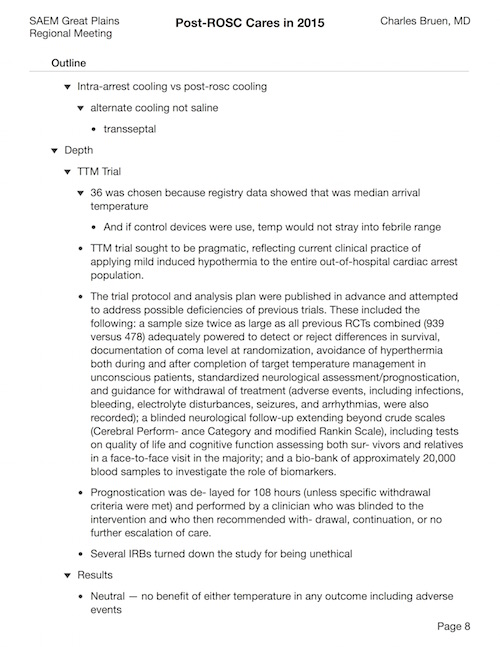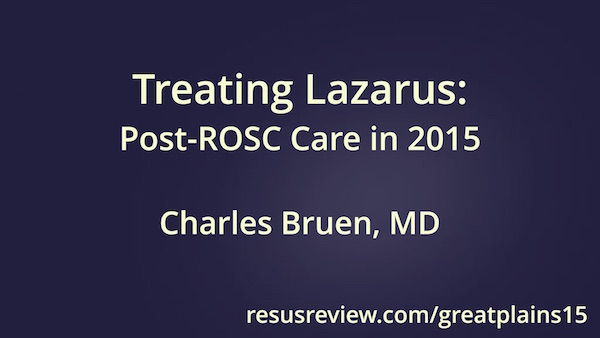
Meeting Information
Presentation — Post-Cardiac Arrest Cares in 2015
| Outline | Slides | |

|

|
Selected Key Readings
-
Prognostication
- Sandroni C, Cariou A, Cavallaro F, et al. Prognostication in comatose survivors && of cardiac arrest: an advisory statement from the European Resuscitation Council and the European Society of Intensive Care Medicine. Intensive Care Med 2014; 40:1816.
- Golan E, Barrett K, Alali AS, et al. Predicting neurologic outcome after & targeted temperature management for cardiac arrest: systematic review and meta-analysis. Crit Care Med 2014; 42:1919.
- Oddo M, Rossetti AO. Early multimodal outcome prediction after cardiac & arrest in patients treated with hypothermia. Crit Care Med 2014; 42:1340
-
Reperfusion
- Camuglia AC, Randhawa VK, Lavi S, Walters DL. Cardiac catheterization is associated with superior outcomes for survivors of out of hospital cardiac arrest: review and meta-analysis. Resuscitation 2014; 85:1533.
- Dumas F, Cariou A, Manzo-Silberman S, et al. Immediate percutaneous ???????? coronary intervention is associated with better survival after out-of-hospital cardiac arrest: insights from the PROCAT (Parisian Region Out of hospital
Cardiac ArresT) registry. Circ Cardiovasc Interv 2010; 3:200.
-
Temperature Management
- Kim F, Nichol G, Maynard C, et al. Effect of prehospital induction of mild hypothermia on survival and neurological status among adults with cardiac arrest: a randomized clinical trial. JAMA 2014; 311:45.
- Nielsen N, Wetterslev J, Cronberg T, et al. Targeted temperature management at 33 degrees C versus 36 degrees C after cardiac arrest. N Engl J Med 2013; 369:2197.
-
Hemodynamics
- Kilgannon JH, Roberts BW, Jones AE, et al. Arterial blood pressure and neurologic outcome after resuscitation from cardiac arrest????. Crit Care Med 2014; 42:2083.
- Young MN, Hollenbeck RD, Pollock JS, et al. Higher achieved mean arterial pressure during therapeutic hypothermia is not associated with neurologically intact survival following cardiac arrest. Resuscitation 2015; 88:158
-
Oxygen
- Wang CH, Chang WT, Huang CH, et al. The effect of hyperoxia on survivalfollowing adult cardiac arrest: a systematic review and meta-analysis of observational studies. Resuscitation 2014; 85:1142.
- Kuisma M, Boyd J, Voipio V, et al. Comparison of 30 and the 100% inspired oxygen concentrations during early postresuscitation period: a randomised controlled pilot study. Resuscitation 2006; 69:199.
-
Carbon Dioxide
- Roberts BW, Karagiannis P, Coletta M, et al. Effects of PaCO derangements on clinical outcomes after cerebral injury: a systematic review. Resuscitation 2015; 91:32.
- Schneider AG, Eastwood GM, Bellomo R, et al. Arterial carbon dioxide tension and outcome in patients admitted to the intensive care unit after cardiac arrest. Resuscitation 2013; 84:927.
- Vaahersalo J, Bendel S, Reinikainen M, et al. Arterial blood gas tensions after resuscitation from out-of-hospital cardiac arrest: associations with long-term neurologic outcome. Crit Care Med 2014; 42:1463
-
Post-arrest Syndrome
- Laurent I, Monchi M, Chiche JD, et al.. Reversible myocardial dysfunction in survivors of out-of-hospital cardiac arrest. J Am Coll Cardiol 2002;40:2110.
- Adrie C, Adib-Conquy M, Laurent I, et al Successful cardiopulmonary resuscitation after cardiac arrest as a “sepsis-like” syndrome. Circulation 2002;106:562.